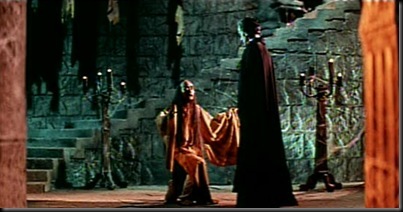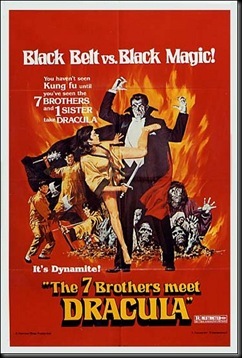
TYPICAL REVIEW
"From a critical standpoint, the film falls flat despite the filmmakers ambitious intentions. But then, how come I still find this film to be so dang entertaining?" - Mark Pollard, Kung Fu Cinema
THE PLOT
Dracula travels to China in order to establish an undead kingdom by awakening the legendary 7 Golden Vampires. Unfortunately for the Count, his old nemesis Dr. Van Helsing happens to be in town giving a lecture and is more than happy to renew his night job as monster hunter supreme. Joining forces with the heroic Hsi Ching, his vampire slaying family, and a rich Swedish adventuress, Van Helsing and his son set out to put an end to the newly risen threat. After surviving a number of assaults, both human and undead, the band of international heroes finally arrive at the vampires' temple on the night of the big ritual. Chaos erupts as the Van Helsings, the Hsis, the Swedish gal, and a small army of villagers face off against Dracula, the 7 Golden Vampires, and a legion of kung fu zombies. Not everybody lives.
THE POINT
When Christopher Lee packed away his cape and fangs for good it looked as if Hammer Studios' classy (and profitable) Dracula franchise might finally come to an end. This was bad news for the troubled Hammer which was already loosing ticket sales to the grittier more realistic horror films of the early 70s. But as we saw with Dr Jekyll & Sister Hyde, when quality wasn't enough to draw people in, Hammer wasn't above resorting to exploitative gimmicks in order to fill seats. So it should come as no surprise that in 1974, following the phenomenon that was the previous year's Enter The Dragon, Hammer would take a swing (so to speak) at making an honest to goodness chopsocky flick. To Hammer's credit however, rather than churn out some half-hearted knock off on their own, they instead enlisted the aid of the undisputed emperor of Hong Kong cinema, Shaw Brothers Studios. (Everything you think you know about kung fu movies comes from the Shaws. Bad dubbing, highly choreographed fights, wire-fu, punches that sound like trees snapping, guys with long white beards; it's all Shaw.) With these two giants joining forces, what could possibly go wrong?
The answer is... who cares? Didn't you read that part up there about kung fu zombies? Kung fu zombies!!! The rest of this movie could be dipped in human waste and it would still be worth watching just for the kung fu zombies. (And I've seen movies in my lifetime which I'm pretty sure have been dipped in human waste, so I should know.) Fortunately, there are a couple of other things to like about Legend Of The 7 Golden Vampires. Peter Cushing is his usual excellent self as Van Helsing, adding a touch of class to an otherwise goofy movie. The old fella even manages to take part in the fisticuffs as well as his age will allow. (Sadly, this was the only movie produced in what was supposed to be a series of globe trotting Van Helsing films. There's more entertainment in five minutes of this movie than the entirety of that 2004 Hugh Jackman debacle.) And the script, rush job that it is, still has a couple of nice surprises. Van Helsing's son Leyland and Vanessa the Swede seem tailor made to be the obligatory love interests, but instead, both fall for members of the Hsi clan. (Oh, uh, there is one Hsi sister. The movie isn't THAT surprising.) Even more shocking is the fact that by the end of the final confrontation all of the Hsi brothers, as well as Vanessa, lie dead on the battlefield.
Actually, that last bit isn't so surprising if you've watched a lot of Asian cinema, especially the films of Cheh Chang, who was basically the uncredited second director on Legend Of The 7 Golden Vampires. There are rarely indestructible western style action heroes in a Cheh film. If a guy goes off on a personal campaign of righteous wrath or a crusade for the greater good in a Cheh movie, he'll probably succeed, but most likely he'll die horribly in the process. It's just one of the little cultural differences that pop up and makes this movie so much fun to watch. Another one that might catch a viewer off guard at first is based on the Chinese belief that the Earth itself rejects the unnatural presence of the living dead. Translated to film, this means you get lots of hilarious scenes of zombies hopping up and down as they come to kill you. And don't expect any suave romantic vampires here. Chinese vampires are rotting husks that in no way inspire you to offer up your neck for a hickey. They wear those golden masks for a reason.
Really, the movie would have been best served to just explore Chinese folk lore and ignore Dracula altogether. Instead, it tries to include both, and if Legend Of The 7 Golden Vampires has one fatal flaw, it's that it doesn't quite manage to successfully mesh the cultural perspectives of its two producing studios. Both culture's mythologies end up getting watered down. For instance, rather than be warded off by the traditional Christian symbols like Dracula always had been, or repelled by things Chinese vampires hate like strips of paper or sticky rice (look it up), this movie's undead are reduced to Universalist Unitarians and are repelled by just about anything someone might remotely consider holy. (For some reason a vampire who would run from a Hare Krishna brandishing a copy of the "Bhagavad Gita As It Is" just seems less threatening.) Worse yet, from a movie standpoint, is the script's inability to meld Hammers ponderous gothic stylings with Shaw's kinetic pacing. The narrative instead settles for abrupt shifts back and forth between looooong passages of Hammer-style exposition and short explosive bursts of Shaw-style martial arts sequences. (I guess there was just no way to make a 50 man free-for-all scream Goth.) In effect, both studios' strengths become hobbled. As a Hammer film, it never achieves the level of horror or sense of atmosphere you find in the earlier Lee/Cushing Dracula outings; as a Shaw film, it never comes anywhere close to the inspired lunacy of movies like Chinese Super Ninjas or Mad Monkey Kung Fu. Don't get me wrong, for an oddball stand-alone movie, Legend Of The 7 Golden Vampires is too weird and silly not to like. But for fans looking for more of either studio's traditional offerings, this movie will be found lacking.
If it's that hard to try and combine two cultures in something as small as a motion picture, imagine how tricky it is for larger, more important things. Marginally successful attempts to introduce Christianity to China appear to have been made by the heretical Nestorians as far back as the 600s, followed by Catholic missionaries in the 13th and 14th centuries. Yet neither effort produced results which were long lasting. It wasn't until the Jesuit Matteo Ricci showed up in 1582 that Christianity began to gain any lasting respect and acceptance. According to the 1912 Catholic Encyclopedia, up until Ricci arrived, "the most difficult problem in the evangelization of China had to do with the rites or ceremonies, in use from time immemorial, to do honour to ancestors or deceased relatives and the particular tokens of respect which the educated felt bound to pay to their master, Confucius." So rather than jump straight into evangelization, Father Ricci first mastered the Chinese language and then embarked on a detailed study of Confucian teachings and traditions. Consequently, he found no conflict between the local customs and Church teachings and thus was able to introduce a Christianity which allowed any converts to keep practicing the old rites honoring Confucius and their ancestors. In effect, before engaging in any evangelization, Father Ricci first indulged in a bit of inculturation.
That seems perfectly in spirit with the Catechism where it states that "Missionary endeavor requires patience. It begins with the proclamation of the Gospel to peoples and groups who do not yet believe in Christ, continues with the establishment of Christian communities that are "a sign of God's presence in the world," and leads to the foundation of local churches. It must involve a process of inculturation if the Gospel is to take flesh in each people's culture." Sadly, the Catechism wasn't around during Father Ricci's time, and a consensus on what constituted proper inculturation had yet to be reached. Professor Joshua Tyler writes that "in what has come to be known as the "Rites Controversy," the Church, under Jansenist influence, determined the Confucian ancestral rite to be pagan... It was not until 1939 that the Church came around to the learned opinion of Fr. Matteo Ricci, that the Confucian ancestral rite was familial, not religious in nature, and Asian Catholics were allowed to participate in it. It has been suggested that the East might be Catholic today were it not for this error." John Paul II expressed his sadness over the whole mess in his 2001 message on the fourth centenary of Ricci's arrival in Beijing in which he apologized for the various errors and events which "placed obstacles in the Church’s path and prevented her from fully carrying out - for the benefit of the Chinese people - the mission entrusted to her by her Founder, Jesus Christ."
Which is all fine and dandy and makes a nice history lesson, but what has it got to do with anything today? On June 20, 2007, Pope Benedict XVI released a letter "To the Bishops, Priests, Consecrated Persons and Lay Faithful of the Catholic Church in the People's Republic of China." It was received well enough by the Chinese government to allow the vice-chairman of the Chinese state-approved Catholic Association, Liu Bainian, to issue an invitation to the Pontiff to come to China. Liu was quick to add, however, that "Beijing will never accept what the church did in Poland." Apparently, the growing religious pluralism in China, most recently among Muslims and Pentecostal Christians, is starting to annoy the Communist regime in China. An article from the Catholic News agency quotes a news release from the China Aid Association which states that "a central government-directed campaign to expel suspected foreign missionaries has been ongoing since February 2007. The groups says this is the largest expulsion since 1954, when the Chinese Communist government expelled all foreign religious workers after taking power in 1949." Since they're going through all the trouble to get rid of all the noisy protestants, the last thing the Chinese government wants right now is another papal super-hero speeding through town in his pope-mobile encouraging dissension in the ranks. But that doesn't appear to be the approach Pope Benedict XVI is taking with China.
With all due respect to the much needed humane efforts put forth by our protestant brethren in China, and a hat tip to the immediate success of their guerilla evangelization techniques (conservative estimates indicate that Protestantism in China has experienced roughly a 4,300 percent growth over the last half-century alone), the current goings-on in China sound awfully familiar to what happened with the Nestorians way back when. Isn't it within reason to think that the short term accomplishments of the Pentecostals could ultimately follow those of the first Christian missionaries into obscurity? Perhaps that's why, in his letter to the Church in China, Pope Benedict XVI writes "I realize that the normalization of relations with the People's Republic of China requires time and presupposes the good will of both parties. For its part, the Holy See always remains open to negotiations, so necessary if the difficulties of the present time are to be overcome. This situation of misunderstandings and incomprehension weighs heavily, serving the interests of neither the Chinese authorities nor the Catholic Church in China. As Pope John Paul II stated, recalling what Father Matteo Ricci wrote from Beijing, "so too today the Catholic Church seeks no privilege from China and its leaders, but solely the resumption of dialogue, in order to build a relationship based upon mutual respect and deeper understanding". Let China rest assured that the Catholic Church sincerely proposes to offer, once again, humble and disinterested service in the areas of her competence, for the good of Chinese Catholics and for the good of all the inhabitants of the country."
It's quite possible that the current Pope's more measured approach to China, which some critics have seen as timid compared to the efforts of protestants, may eventually bear more fruit farther down the line. And it's quite possible that "farther" could mean generations. As frustrating as that is, the Catechism reminds us that "with regard to individuals, groups, and peoples it is only by degrees that [the Church] touches and penetrates them and so receives them into a fullness which is Catholic." As always, we're on God's time. We try to rush the combining of the two cultures and we could end up with something along the lines of Legend Of The 7 Golden Vampires; a tangled mess that's got some interesting features, but is ultimately unfulfilling to either side.
THE STINGER
China and Catholicism already have some common talking points. As Professor Joshua Tyler notes, while Confucius himself "denied the existence of the spirits, he affirmed the importance of ceremonial propriety in the orientation of man toward the good." The Confucian concept of "li" (variously translated as "etiquette," "ceremony," "rite," "ritual," or "propriety") proscribed "a precise following of the rubrics without the slightest deviation in the ancestral rite... The Confucian understanding of "li" went beyond the ancestral rite to include ceremonial music and human relationships as well. It is obvious where Confucius would stand in the liturgical battles of the past four decades; he would be on the side of those who want Gregorian Chant and Palestrina, not folk guitars, at Mass." Confucius might say, "Bite me, OCP!"
(Whew. Another long rambling post that started out as one thing, turned into another, and had to be retyped. I don't see how the rest of you manage to blog on a regular basis.)




